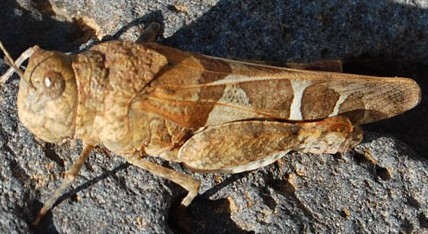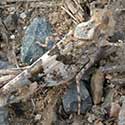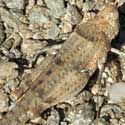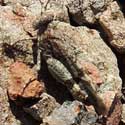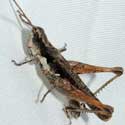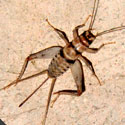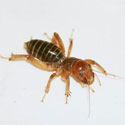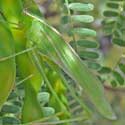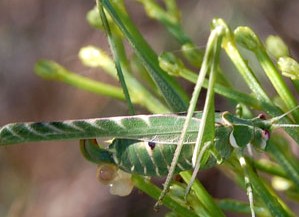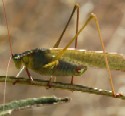Alkali Grasshopper
Anconia integra
Medium-sized grasshopper with large prominent eyes. Tegmina with pale rectangular splotches. Color can be green, brown or grayish. More info
Many Hued Grasshopper
Poecilotettix sanguineus
Gaudily colored. Generally hides in desert shrubs. Medium sized. More info
Humphrey's Grasshopper
Barytettix humphreysii
Adults have short, non-functional wings. Spur-like process on venter between head and thorax. Three dark trapezoids on sides of pronotum. More info
Blue-winged Grasshopper
Leprus intermedius
Mottled with shades of brown and tan. Membraneous wings in flight distinctly blue. Clacking sound when flying. More info
Yarrow's Grasshopper
Melanplus yarrowii
There are many species of Melanoplus spur-throats in Sonoran Desert. Clear yellow-brown with dark lateral marks on pronotum. More info
Pallid-winged Grasshopper
Trimerotropis pallidipennis
Well camouflaged grasshopper often alighting on bare ground and having excellent flight capabilities. Occasionally abundant. More info
Cream Grasshopper
Cibolacris parviceps
In bright sunlight and perched on bleach desert gravel these hoppers make themselves nearly invisible. More info
Aztec Grasshopper
Lactista azteca
Small agile grasshopper that disappears after alighting among rocks. Hind wings (concealed) marked with yellow and gray. More info
Ash-Gray Range Grasshopper
Horesidotes cinereus
This is one of the 'slant-faced' grasshopper so-called based on the head profile. More info
Horse Lubber Grasshopper
Taeniopoda eques
Black with gaudy markings in green and yellow. Underwings are pink. Very large and robust. Southeast Arizona only. More info
Tropical House Cricket
Gryllodes sigillatus
Common to abundant cricket mostly in urban settings often taking up residence in homes and warehouses. Adult males chirp almost incessantly with nightfall. More info
Jerusalem Cricket
Stenopelmatus
Adults are large with a strong convex head and thorax. Without wings the segmented abdomen is exposed. Eats other insects. More info
Tree Cricket
Oecanthus sp.
Delicate green with gossamer wings. Long hair-like antennae. Inhabits shrubs and trees; hides well. Several similar species. More info



